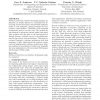Free Online Productivity Tools
i2Speak
i2Symbol
i2OCR
iTex2Img
iWeb2Print
iWeb2Shot
i2Type
iPdf2Split
iPdf2Merge
i2Bopomofo
i2Arabic
i2Style
i2Image
i2PDF
iLatex2Rtf
Sci2ools
ICSE
2000
IEEE-ACM
2000
IEEE-ACM
Dragonfly: linking conceptual and implementation architectures of multiuser interactive systems
Software architecture styles for developing multiuser applications are usually defined at a conceptual level, abstracting such low-level issues of distributed implementation as code replication, caching strategies and concurrency control policies. Ultimately, such conceptual architectures must be cast into code. The iterative design inherent in interactive systems implies that significant evolution will take place at the conceptual level. Equally, however, evolution occurs at the implementation level in order to tune performance. This paper introduces Dragonfly, a software architecture style that maintains a tight, bidirectional link between conceptual and implementation software architectures, allowing evolution to be performed at either level. Dragonfly has been implemented in the Java-based TeleComputing Developer (TCD) toolkit. Keywords Software architecture, user interface development toolkits, groupware
Conceptual Level | ICSE 2000 | Software Architecture | Software Architecture Style | Software Engineering |
| Added | 25 Aug 2010 |
| Updated | 25 Aug 2010 |
| Type | Conference |
| Year | 2000 |
| Where | ICSE |
| Authors | Gary E. Anderson, T. C. Nicholas Graham, Timothy N. Wright |
Comments (0)

